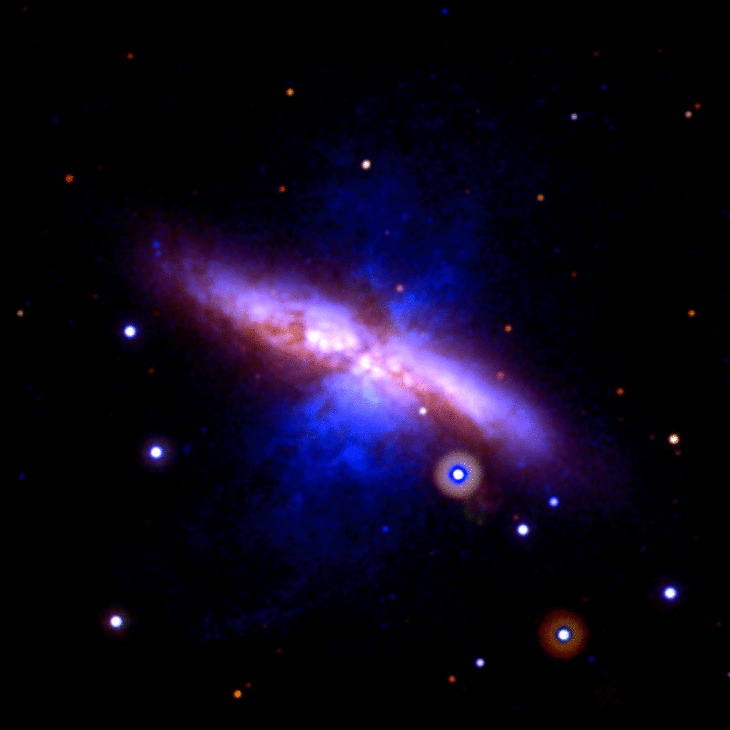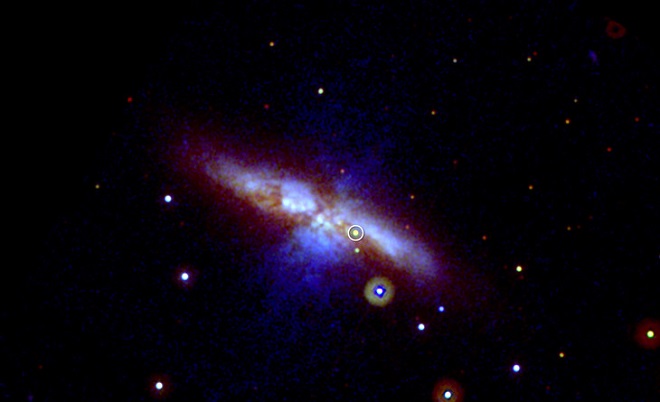January 24, 2014
Francis Reddy / Barbara K. Kennedy
An exceptionally close exploding star, discovered on Jan. 21, is the focus of observatories on Earth and in orbit, including the Swift Satellite and several other NASA spacecraft. The science and flight operations of the Swift Observatory are controlled by Penn State from the Mission Operations Center at the University Park campus. The Swift Observatory was the first to take a look at this supernova.
The blast, named SN 2014J, occurred in the galaxy M82 and lies only about 12 million light-years away. It is the nearest supernova in two decades that can be seen in visible light. It also is potentially the closest type-Ia supernova that will have occurred during the life of the currently operating space missions.

This animated GIF of Swift UVOT images shows M82 before and after the new supernova. The pre-explosion view combines data taken between 2007 and 2013. The view showing SN 2014J (arrow) merges three exposures taken on Jan. 22, 2014. Mid-ultraviolet light is shown in blue, near-UV light in green, and visible light in red.
Image: NASA/Swift/P. Brown, TAMU
Astronomers expect SN 2014J to continue brightening into the first week of February, by which time it may be visible from Earth with binoculars. M82, also known as the Cigar Galaxy, is located in the constellation Ursa Major and is a popular target for small telescopes. M82 is undergoing a powerful episode of star formation that makes it many times brighter than our own Milky Way galaxy and accounts for its unusual and photogenic appearance.
"We are delighted to use Swift's built-in, near-immediate response capability to make early, frequent, and continuing observations of this new supernova, which is the closest supernova that has occurred in the last 20 years," said John Nousek, director of the Mission Operations Center and a professor of astronomy and astrophysics at Penn State.
Michael Siegel, senior research scientist on the Swift team at Penn State, said "Swift is especially well-suited to studying supernovae, since we can study them in the optical, ultraviolet and X-ray wavelengths at the earliest stages, when you can learn the most about the physics. Over the nine years of the mission, we have observed about 200 supernovae. Each one is amazing, but this one is particularly fascinating because it is behind a thick wall of dust and because it is so close to us."
To make the most of the M82 supernova event, astronomers have planned observations with the NASA/ESA Hubble Space Telescope, NASA's Chandra X-ray Observatory, the Nuclear Spectroscopic Telescope Array (NuSTAR), and the Fermi Gamma-ray Space Telescope, in addition to the Swift Observatory.
On Jan. 22, just a day after the explosion was discovered, Swift's Ultraviolet/Optical Telescope (UVOT) captured the supernova and its host galaxy. "This UV image of M82, with its new supernova, is likely to be one of the iconic images from the entire Swift mission, using Swift's unique UVOT instrument to combine the UV bright filaments of the galaxy with the brilliant light of the exploding supernova," Nousek said. "The UVOT has unique wide-field imaging capabilities that allow us to follow the UV light curve of the supernova and also to make dramatic combined images of the galaxy along with the extraordinary radiation from the supernova in its heart."
Swift's Ultraviolet/Optical Telescope is lead by Penn State, with crucial support from the Mullard Space Sciences Lab in the United Kingdom and NASA's Goddard Space Flight Center. Remarkably, SN 2014J can be seen on images taken up to a week before anyone noticed its presence. It was only when Steve Fossey and his students at the University of London Observatory imaged the galaxy during a brief workshop that the supernova came to light.
"Finding and publicizing new supernova discoveries is often the weak link in obtaining rapid observations, but once we know about it, Swift frequently can observe a new object within hours," said Neil Gehrels, the mission's principal investigator at NASA's Goddard Space Flight Center.
Although the explosion is unusually close, the supernova's light is diluted by thick dust clouds in its galaxy, which may slightly reduce its apparent peak brightness.
"Interstellar dust preferentially scatters blue light, which is why Swift's UVOT sees SN 2014J brightly in visible and near-ultraviolet light but barely at all at mid-ultraviolet wavelengths," said Peter Brown, astrophysicist at Texas A&M University who leads a team using Swift to obtain ultraviolet observations of supernovae.
Brown notes that X-rays have never been conclusively observed from a type Ia supernova, so a detection by Swift's X-ray Telescope, Chandra, or NuSTAR would be significant, as would a Fermi detection of high-energy gamma rays.
The total destruction of a white dwarf star by one of two possible scenarios results in a type Ia supernova. In one, the white dwarf orbits a normal star, pulls a stream of matter from it, and gains mass until it reaches a critical threshold and explodes. In the other, the blast begins when two white dwarfs in a binary system eventually spiral inward and collide.
Either way, the explosion produces a superheated shell of plasma that expands outward into space at tens of millions of miles an hour. Short-lived radioactive elements formed during the blast keep the shell hot as it expands. The interplay between the shell's size, transparency and radioactive heating determines when the supernova reaches peak brightness.
This super-close supernova provides astronomers with an important opportunity to study how interstellar dust affects its light. As a class, type Ia supernovae explode with remarkably similar intrinsic brightness, a property that makes them useful "standard candles" -- some say "standard bombs" -- for exploring the distant universe.













